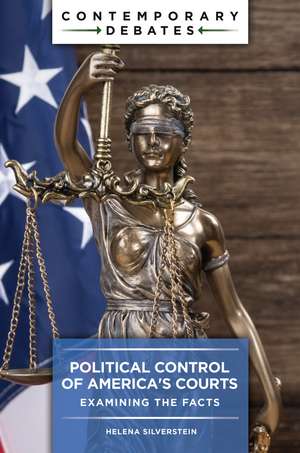Political Control of America's Courts: Examining the Facts: Contemporary Debates
Autor Helena Silversteinen Limba Engleză Hardback – 17 ian 2023 – vârsta până la 17 ani
Din seria Contemporary Debates
- 11%
 Preț: 345.90 lei
Preț: 345.90 lei - 43%
 Preț: 273.55 lei
Preț: 273.55 lei - 43%
 Preț: 274.02 lei
Preț: 274.02 lei - 50%
 Preț: 257.66 lei
Preț: 257.66 lei -
 Preț: 146.61 lei
Preț: 146.61 lei - 5%
 Preț: 140.96 lei
Preț: 140.96 lei - 42%
 Preț: 273.11 lei
Preț: 273.11 lei - 43%
 Preț: 268.84 lei
Preț: 268.84 lei - 42%
 Preț: 269.79 lei
Preț: 269.79 lei - 48%
 Preț: 271.22 lei
Preț: 271.22 lei -
 Preț: 104.20 lei
Preț: 104.20 lei - 42%
 Preț: 270.72 lei
Preț: 270.72 lei - 42%
 Preț: 272.25 lei
Preț: 272.25 lei - 42%
 Preț: 269.60 lei
Preț: 269.60 lei - 42%
 Preț: 271.68 lei
Preț: 271.68 lei -
 Preț: 250.02 lei
Preț: 250.02 lei -
 Preț: 269.79 lei
Preț: 269.79 lei - 42%
 Preț: 271.22 lei
Preț: 271.22 lei -
 Preț: 270.64 lei
Preț: 270.64 lei -
 Preț: 272.25 lei
Preț: 272.25 lei - 43%
 Preț: 273.55 lei
Preț: 273.55 lei
Preț: 281.16 lei
Preț vechi: 474.09 lei
-41% Nou
Puncte Express: 422
Preț estimativ în valută:
53.80€ • 56.31$ • 44.78£
53.80€ • 56.31$ • 44.78£
Carte tipărită la comandă
Livrare economică 31 martie-14 aprilie
Preluare comenzi: 021 569.72.76
Specificații
ISBN-13: 9781440878053
ISBN-10: 1440878056
Pagini: 224
Dimensiuni: 156 x 235 x 20 mm
Greutate: 1.04 kg
Editura: Bloomsbury Publishing
Colecția ABC-CLIO
Seria Contemporary Debates
Locul publicării:New York, United States
ISBN-10: 1440878056
Pagini: 224
Dimensiuni: 156 x 235 x 20 mm
Greutate: 1.04 kg
Editura: Bloomsbury Publishing
Colecția ABC-CLIO
Seria Contemporary Debates
Locul publicării:New York, United States
Caracteristici
Uses quantifiable data from authoritative sources as the foundation for examining every issue
Notă biografică
Helena Silverstein js Professor and Department Head of Government and Law at Lafayette College, USA.
Cuprins
AcknowledgmentsHow to Use This Book1. Nominations, Confirmations, and Departures of Federal JudgesQ1. Are nominations and confirmations to the federal bench based on factors beyond merit? Q2. Do outside organizations influence whom the president nominates to the federal bench? Q3. Do interest groups influence the Supreme Court confirmation process? Q4. Is it unusual for the Senate to reject a Supreme Court nominee? Q5. Was the Senate's refusal to take action on President Obama's Supreme Court nomination of Merrick Garland really unprecedented? Q6. Are Supreme Court confirmation hearings a "vapid and hollow charade"? Q7. Is the timing of judicial retirements from the Supreme Court influenced by politics? Q8. Did President Trump's judicial appointments fundamentally re-make the federal judiciary for decades to come? 2. Judicial Elections to State CourtsQ9. Have contested judicial elections become more political over recent decades? Q10. Are nonpartisan judicial elections less political than partisan judicial elections? Q11. Has politicization of judicial retention elections increased? Q12. Does the growth of campaign spending by interest groups affect judicial independence? Q13. Do politicized judicial elections threaten the legitimacy of state courts? 3. Structures Affecting the Courts Q14. Has Congress or the president ever sought to adjust the size of the Supreme Court for political gain? Q15. Can Congress strip the Supreme Court and lower federal courts of their jurisdiction? Q16. Would term limits make the Supreme Court less politicized? Q17. Was the end of the filibuster in federal judicial confirmations a historic rule change? Q18. Is the end of the filibuster in federal judicial confirmations likely to increase polarization onthe federal courts?4. Decisions and Decision MakingQ19. Are Supreme Court justices influenced by public opinion? Q20. Do judges' political attitudes and ideologies influence their legal decisions? Q21. Did the Supreme Court's "switch in time that saved nine" occur in direct response to external political pressure? Q22. Is the influence of amicus briefs on the Supreme Court growing? Q23. Is the Supreme Court using the "shadow docket" more frequently?5. Public Perceptions of the JudiciaryQ24. Is public faith and confidence in the Supreme Court in decline? Q25. Does the public believe the courts are political and partisan? Q26. Does the public's perception of the judiciary vary by party affiliation? Q27. Has the judicial philosophy known as "originalism" become dominant in American jurisprudence and accepted by the public? 6. Politicization, Partisanship, and Legitimacy Q28. Were President Trump's criticisms of the judiciary unusual? Q29. Has the Supreme Court become more partisan? Q30. Is the Supreme Court facing a legitimacy crisis? Subject IndexAbout the Author
